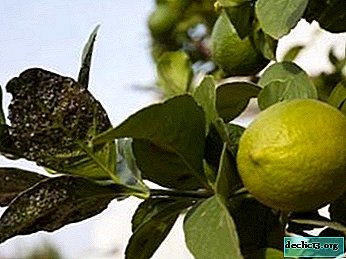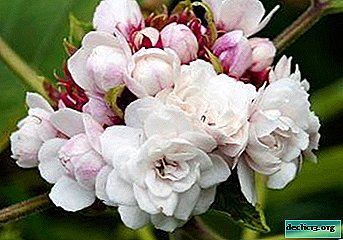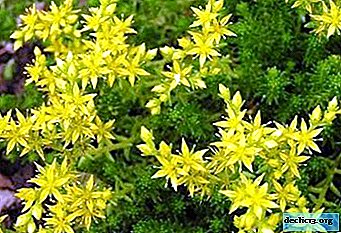Flowers, grass and shrubs with the smell of lemon: names, description and photo
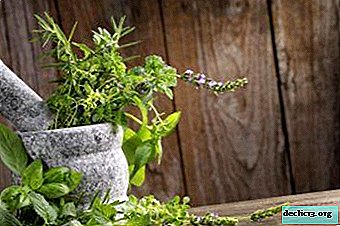
The aroma of lemon, fresh and juicy, uplifting, gives a sense of vigor and with its bright energy recalls the summer.
Unfortunately, it is difficult to grow a lemon tree in Russian latitudes, but there are plants with a similar smell that easily take root in cold soil and have a lot of useful properties.
We will tell you about the most interesting plants with a lemon smell, show their photos and tell how they can be used.
Indoor flowers with lemon aroma: names, description and photo
Fragrant geranium (Pelargonium graveolens)

A plant with small flowers of pink or purple hue. The leaves are carved, resembling grapes, covered with tiny villi on both sides. The plant can reach a height of more than one meter.
Geranium has antiseptic properties, kills bacteria in the air and absorbs odors, so this plant found a place in the kitchen.
It is characterized by a calming effect and is widely used in aromatherapy.We offer you to watch a video about fragrant geranium:
Murray

Evergreen tree reaching a height of 1.5 meters at home. The leaves are dark green in color with a distinct citrus flavor and smell. A distinctive feature of the plant is the simultaneous appearance of delicate white flowers of small size and red elongated berries that look similar to rosehips.
- Phytoncides, which are contained in the leaves, purify polluted air, contribute to the treatment of headaches and cardiovascular diseases: hypertension, angina pectoris and more.
- Trace elements enhance mood and stimulate mental activity.
- Murray berries, sweet in taste, tone up and are used to prevent the body from withering.
We offer you to watch a video about the Muraya plant:
Plectranthus fragrant or shporotsvetnik

Perennial herb with fleshy rounded leaves covered with hairs. White, lilac and violet bell-shaped flowers of the flowerbed are collected in multi-flowered inflorescences. At home, reaches 80 centimeters in height.
If you break the plant, you can feel a strong mint-lemon aroma.Medicinal infusions of aromatic plectranthus:
- have anti-inflammatory and analgesic effects;
- have a mild laxative effect;
- help with heartburn and gastritis;
- improve appetite;
- relieve rheumatism.
Spicy and medicinal herbs, the leaves of which smell like citrus
Melissa officinalis

Grown in Europe and North America. A perennial herb with oval leaves with denticles at the ends and a relief structure. The inflorescence consists of several small corollas with white or bluish petals.
- Melissa-based drugs have a pronounced sedative effect. They contribute to the treatment of insomnia, relieve cramps, have choleretic, diuretic and healing effects.
- Tea lowers blood pressure and soothes the inflamed mucous membranes of the digestive tract.
Drinking lemon balm is good for women's health:
- normalizes the menstrual cycle;
- relieves inflammation of the appendages;
- during pregnancy relieves toxicosis.
We offer you to watch a video about Melissa officinalis:
Cat mint

Distributed in central Russia, in southern and central Europe, in the North Caucasus, the Far East and the USA.
The plant is about one meter tall and has a woody stem with carved heart-shaped leaves, the inflorescence consists of small petals of a white or lilac hue.Cat mint:
- treats insomnia;
- calms nerves;
- facilitates the elimination of sputum in bronchitis;
- relieves spasms of the brain and intestines;
- causes appetite.
The plant is used in the veterinary field, for the prevention of the appearance of worms in animals, as well as a sedative for cats.
We offer you to watch a video about catnip:
Moldavian Snakehead

Grows in most of Eurasia and North America in a temperate climate. A herbaceous plant, with small elongated leaves with teeth along the edges. Purple flowers form a racemose. The snakehead grows to 80 centimeters.
Plant:
- May help with neuralgia, headache and toothache.
- Improves digestion.
- Increases immunity.
- It has a choleretic effect.
- has an antiseptic effect.
- Heals wounds and relieves inflammation.
We offer you to watch a video about the Moldavian snakehead:
Lemon Basil (Ocimum x citriodorum)

It came from Central and South Asia and spread throughout the world. Plant height up to 50 centimeters. Strong branchy stem with many small rough leaves of oblong shape. Flowers form on top of a branch and have a white or pale pink tint.
Used for diseases of the gastrointestinal tract and bladder, flatulence and bloating.Lemon Verbena (Aloysia citriodora, Aloysia triphylla)

It grows on almost all continents, but South America is considered its homeland. A lush plant with narrow arched leaves. It blooms in small inflorescences of a light purple hue (resembles a lilac branch). Has a pronounced lemon smell.
Verbena:
- treats diseases of the digestive tract;
- calms the nervous system;
- tones the body;
- improves mood.
It is a real salvation for skin rashes, evens complexion and rejuvenates.
We offer you to watch a video about lemon verbena:
Lemon Thyme (Thymus x citriodorus)

Grown in the temperate climate of the northern hemisphere. Perennial plant, up to 30 centimeters high.
Leaflets are rounded and small, dark green in the middle and with a pale green tint at the edges. The flowers are lilac.- In medicine, the plant has proven effective in diseases of the respiratory tract.
- It inhibits the development of pathogenic microflora.
- Normalizes the production of gastric juice.
- Strengthens heart health.
- Helps improve sleep.
We suggest watching a video about lemon thyme:
Lemon savory

Distributed on all continents, originally comes from the Mediterranean. Perennial with creeping shoots and narrow elongated bright green leaves. Pink or purple flowers emit a concentrated lemon scent.
It is used as an antibacterial and anthelmintic agent. Helps to cope:
- with a headache;
- tachycardia;
- cystitis;
- with gastrointestinal diseases.
Lemongrass

It grows in India, Thailand, China, Africa and America. Evergreen perennial plant looking like a bunch of grass. In a tropical climate it can reach 1.8 meters in height.
- Lemongrass normalizes the digestive system.
- Effective for headaches, skin rashes, rheumatism.
- Increases the tone and performance of the body, helps fight colds.
- Reduces oily hair, removes toxins, burns cellulite.
Marigold Lemmon

Lemon marigolds are a perennial herb up to 120 centimeters tall with narrow long leaves of 5-15 centimeters. Small yellow flowers exude an amazing aroma, a mixture of citrus, mint and a subtle note of camphor. The homeland of the plant is called the USA and Mexico..
Marigold oil has antimicrobial, antifungal, antispasmodic and sedative properties.Shrubs
Wormwood medicinal "God's tree" (Artemisia abrotanum)
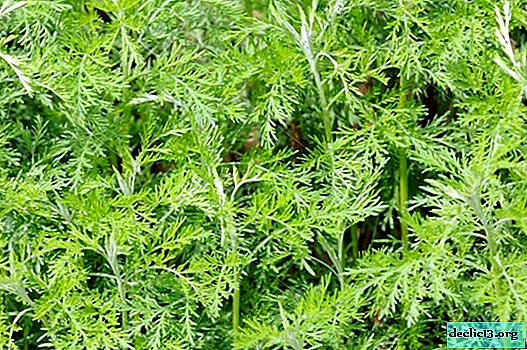
Widely distributed in Russia, in the European part, in Siberia and the North Caucasus. Perennial shrub, up to 150 centimeters high. The leaves are bluish-green, pressed down from the bottom, covered with a gray fluff. Small yellow flowers in small, drooping baskets are collected at the top of the stem and form a spreading panicle inflorescence.
Decoctions of wormwood leaves are used for:
- colds, flu, tonsillitis;
- rheumatism;
- toothache, gum disease;
- menstrual irregularities;
- as a choleretic agent;
- to strengthen hair.
We offer to watch a video about wormwood:
Callistemon lemon

Mostly distributed in Australia, in Russia it is grown at home. In the wild, the bush reaches 3 meters in height., has green, linear-lanceolate, leaves, sharp at the apex, up to 9 cm long and 1 cm wide. Flowers of unusual shape, reminiscent of "kitchen brushes" red or pink. Leaves exude a bright lemon scent.
Callistemon lemon has antibacterial properties and is able to disinfect indoor air.
We offer you to watch a video about lemon callistemon:
Most plants, herbs and flowers smelling of lemon aroma not only perfectly mimic the citrus smell, but also are a source of valuable natural trace elements. Their proper use will give a person beauty and health for a long time.







